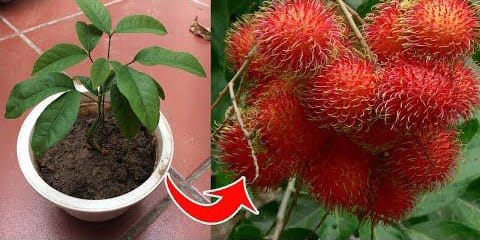
റമ്പുട്ടാൻ നടുമ്പോൾ ശ്രദ്ധിക്കേണ്ട കാര്യങ്ങൾ Farming rambutan (Nephelium lappaceum)
റംബുട്ടാൻ അധികം വെള്ളം വേണം എന്നുള്ളത് മാത്രമല്ല വേണ്ട കുറച്ചു കാര്യങ്ങൾ കൂടെയുണ്ട് മണ്ണിൽ നിന്നു തന്നെ അത് ചെയ്തു തുടങ്ങേണ്ടതായിട്ടുണ്ട് മണ്ണ് നമുക്ക് നല്ലപോലെ വളക്കൂറുള്ളതാക്കി മാറ്റണം അതിനായിട്ട് നമുക്ക് ചാണകപ്പൊടിയും അതുപോലെതന്നെ എല്ലുപൊടിയും ഒപ്പം തന്നെ കടല പിണ്ണാക്കും ഒക്കെ ചേർത്തു കൊടുക്കണം ഒപ്പം തന്നെ ഇതിലേക്ക് ഉപ്പും കൂടി ചേർത്ത് കൊടുക്കണം എല്ലാം ചേർത്ത് നന്നായിട്ട് മിക്സ് ചെയ്ത് യോജിപ്പിച്ച്
നമുക്ക് മണ്ണ് തന്നെ ശരിയാക്കി എടുക്കണം അതിനുശേഷം ഇതില് നിറയെ വെള്ളം ഒഴിച്ചു കൊടുക്കാൻ ശ്രദ്ധിക്കുക നമ്മുടെ നാട്ടിൽ അധികം ഇല്ലാത്ത ഒരു സാധനമാണ് കാരണം നമ്മുടെ കാലാവസ്ഥ തന്നെയാണ് കാലാവസ്ഥയ്ക്ക് അനുസരിച്ച് നമ്മൾ മണ്ണിനെയും ചെടിയെ മാറ്റിയെടുക്കുക എന്നുള്ളതാണ് ഏറ്റവും വലിയ പ്രധാനപ്പെട്ട കാര്യം അതിനായിട്ട് നമുക്ക് ചെയ്യേണ്ടത് ഇത്ര മാത്രമേ ഉള്ളൂ അപ്പോൾ റംബുട്ടൻ നമുക്ക് വളർത്തിയെടുക്കാനും വളരെ

എളുപ്പമാണ് ഇതിന്റെ ഏറ്റവും കൂടുതൽ പ്രധാനം ഉള്ള കാര്യം ഇതിന്റെ കാലാവസ്ഥ കണക്കാക്കി നമുക്ക് ഇതിനെ ഒരുപാട് വെയില് കൊള്ളുന്നത് ഒരുപാട് ചൂടുള്ള നടേണ്ടത് കുറച്ചധികം പ്രത്യേകതകളുണ്ട് എന്തൊക്കെയാണ് എന്നുള്ളത് വീഡിയോയിൽ കൊടുത്തിട്ടുണ്ട്. വീഡിയോ നിങ്ങൾക്ക് തീർച്ചയായിട്ടും ഉപകാരപ്പെടും വീഡിയോ കാണുന്ന പോലെ പരിചരണം കൊടുത്തു കഴിഞ്ഞാൽ നിറയെ നമ്മുടെ വീട്ടിൽ തന്നെ ഉണ്ടാവുന്നതാണ്.
Basic Overview
| Feature | Details |
|---|---|
| Climate | Tropical, warm, and humid |
| Rainfall | 1500–3000 mm annually |
| Temp Range | 22°C–35°C (no frost) |
| Soil Type | Deep, fertile, well-drained loamy soil |
| pH | 5.5 – 6.5 |
| Fruit Yield | 200–300 fruits/tree (after 5–7 yrs) |
🌱 Planting Rambutan
1. Propagation
- Grown mostly from air-layering, grafting, or budding (faster and true to type).
- Seeds take 8–10 years to fruit and may not be true to parent plant.
- Buy grafted saplings from a reliable nursery.
2. Planting Time
- Best time: June–July (early monsoon)
- Dig a pit: 2 ft × 2 ft × 2 ft
- Mix compost or well-rotted manure + neem cake before planting
3. Spacing
- 10–12 meters between plants (they grow tall and wide)
- Intercropping is possible in early years (pineapple, banana)
💧 Watering & Irrigation
- Young plants need regular watering (2–3 times/week)
- Mature trees: irrigate during dry spells or flowering
- Avoid waterlogging — causes root rot
- Mulch around base to retain moisture and suppress weeds
🧂 Fertilizer Schedule
| Age of Tree | Manure/Fertilizer Recommendation per year |
|---|---|
| Year 1–2 | 10 kg compost + 100g NPK 10:10:10 |
| Year 3–4 | 20 kg compost + 200g NPK |
| Mature tree | 30–40 kg compost + 500g NPK + micronutrients |
- Split fertilizer into 2 or 3 doses/year
- Apply during pre-flowering and post-harvest
- Use zinc, magnesium, boron if deficiency signs appear
🐛 Pest & Disease Control
| Problem | Control |
|---|---|
| Fruit borer | Neem oil spray or light traps |
| Mealybugs & aphids | Insecticidal soap / neem oil |
| Anthracnose (fungus) | Copper oxychloride / Mancozeb spray |
| Root rot | Improve drainage, use Trichoderma |
🛑 Tip: Always use organic methods for early-stage plants and during flowering.
🌸 Flowering & Fruit Development
- Begins 3–4 years after planting (grafted)
- Flowers are male, female, or hermaphrodite
- Plant both male and female varieties for better pollination
- Honeybees are the main pollinators — avoid heavy pesticide use
🍒 Harvesting Rambutan
- Fruits are ready 15–20 weeks after flowering
- Harvest when fruits are bright red or yellow (depending on variety)
- Use clean scissors or pruners to avoid damaging branches
- Fruits do not ripen after harvest — pick only ripe ones
📦 Post-Harvest Handling
- Perishable — lasts only 2–5 days
- Store in cool, humid place (refrigerated at 10–12°C)
- Best for fresh markets, juice, jam, or export
🌟 Extra Tips for Success
✅ Choose varieties like:
- Rongrien (sweet and less hairy)
- Jitlee, Binjai, Lebakbulus — high yielding Southeast Asian types
✅ Avoid growing in salty or clay-heavy soil
✅ Prune yearly to shape tree and improve air circulation
✅ Encourage natural pollinators (bees) by planting flowering herbs nearby
